Afghanistan In Pictures
Ten years ago, U.S. forces began bombing Afghanistan in retaliation against its Taliban rulers who refused to hand over the al Qaeda leaders responsible for the Sept. 11, 2001 attacks on the United States. Within weeks, the air strikes had helped Afghan opponents topple the Taliban, but in the decade since, the deposed Islamist fighters have returned to mount an ever more aggressive insurgency against an Afghan government backed by the United States and NATO. Since U.S. President Barack Obama took office in 2009, the U.S. force has tripled in size, but Washington and NATO now plan to begin withdrawing and to hand over responsibility for Afghanistan's security to Afghan forces by 2014.
More pictures are at
Afghanistan1.pps.
Others are at
Afghanistan
In 1967 ![]()
From Afghan war - Iconic images | Analysis & Opinion | Reuters
1 of 50 |
Afghan opposition Northern Alliance soldiers run and jump as they
return from a front line position after battle near the town of Charatoy in the north of Afghanistan October 10, 2001. REUTERS/Gleb Garanich
1 of 50 |
A young Afghan woman shows her face in public for the first time after 5 years
of Taliban Sharia law as she waits at a food distribution center in central
Kabul November 14, 2001.
REUTERS/Yannis Behrakis
28 of 50 | A French sniper (R) looks
through his rifle's scope while keeping watch over Qarabagh district, about 40
km (25 miles) north of Kabul, November 20, 2007.
REUTERS/Ahmad Masood
35 of 50 |
A donkey transports ballot boxes to villages unreachable by vehicles in Panjshir
province, north of Kabul September 17, 2010.
REUTERS/Ahmad Masood 3 of 50 | US
Marines from Charlie 1/1 of the 15th MEU (Marine Expeditionary Unit)
fill sand bags around their light mortar position on the front lines
of the US Marine Corps base in southern Afghanistan December 1, 2001
nearby a cardboard sign reminding everyone that the Taliban forces
could be anywhere and everywhere. REUTERS/Jim
Hollander
4 of 50 |
Residents of Kabul make their way to greet Northern Alliance fighters
arriving in the outskirts of the Afghan capital Kabul November 13,
2001. REUTERS/Yannis Behrakis
5 of 50 | An Afghan
refugee girl in the Kili Faizu UNHCR Camp in Chaman, Pakistan reacts after
spotting a jet flying overhead, November 10, 2001. REUTERS/Adrees
Latif
6 of 50 |
Anti-Taliban Afghan fighters watch several explosions from U.S.
bombings in the Tora Bora mountains in Afghanistan December 16, 2001. REUTERS/Erik de Castro "Ten years ago I was part
of the three-member Reuters multimedia team that went to Afghanistan
following the 9/11 attacks on the U.S. We covered the pursuit for
Osama Bin Laden and his Taliban followers, who were believed to be
holed up in the caves of the Tora Bora mountains, by US military
special forces fighting alongside the Afghan Mujaheedin. Nobody from
the press saw Osama. Instead about a dozen Taliban captured from the
caves were presented to the media in Tora Bora."
7 of 50 | A man
cries over the body of his son and neighbors who died in U.S. raids in the
Afghan capital Kabul on October 28, 2001. REUTERS/Sayed
Salahuddin
8 of 50 |
Pro-Taliban fighters including foreigners nest behind the iron bars to
gain some space in an overcrowded Sibirgan prison near the northern
Afghan city of Mazar-i Sharif, December 5, 2001. REUTERS/Faruk Zabci-HURRIYET
10 of 50 | A young
amputee boy walks through the Eidgah mosque in the city of Kabul December 8,
2001 where the U.N. World Food Programme (WFP) started its biggest ever food
distribution in the Afghan capital, handing out sacks of wheat to more than
three-quarters of the war-ravaged city's population. REUTERS/Peter Andrews 11 of 50 | Osama
bin Laden (L) sits with his adviser Ayman al-Zawahri, an Egyptian linked to the
al Qaeda network, during an interview with Pakistani journalist Hamid Mir (not
pictured) in an image supplied by the respected Dawn newspaper November 10,
2001. REUTERS/Hamid Mir/Editor/Ausaf Newspaper for Daily
Dawn 12 of 50 | An
Afghan man walks by stacks of worthless Afghani notes in an underground
strongroom of the country's national bank in Kabul November 29, 2001. REUTERS/Damir Sagolj 13 of 50 | An
Afghan soldier uses a wooden stick to maintain order among women waiting for
humanitarian aid at a World Food Programme WFP distribution point in the city of
Kabul December 14, 2001. REUTERS/Damir Sagolj
8 of 50 | Joint
Terminal Attack Controller SSgt Clinton J. Herbison, a U.S. Airman from the 817
Expeditionary Air Support Operations Squadron (EASOS) takes a break during a
night mission near Honaker Miracle camp at the Pesh valley of Kunar Province
August 12, 2009. REUTERS/Carlos Barria 19 of 50 |
A victim is taken away from the site of a bomb blast in Kabul December 15, 2009. REUTERS/Ahmad Masood
22
of 50 | Graffiti left behind by Taliban
fighters remains on the walls of a compound now used as a command
center for the U.S Marine Corps's First Battalion, Eighth Marines at
Musa Qala in southern Afghanistan's Helmand province, November 10,
2010. REUTERS/Finbarr
O'Reilly
23
of 50 | A wounded Canadian soldier from
the NATO-led coalition crawls for cover seconds after his position was
hit by a Taliban shell fired from an 82-millimeter recoilless rifle
during an ambush in Zhari district of Kandahar province, southern
Afghanistan, October 23, 2007. REUTERS/Finbarr O'Reilly
24
of 50 | U.S. Marine Lance Corporal Chris
Sanderson, 24, from Flemington, New Jersey shouts as he tries to
protect an Afghan man and his child after Taliban fighters opened fire
in the town of Marjah, in Nad Ali district, Helmand province, February
13, 2010. REUTERS/Goran
Tomasevic “I was following the U.S. Marines from the 1st Battalion,
6th Regiment Bravo Company during the U.S.-led offensive on the
Taliban stronghold of Marjah in Helmand Province, southern
Afghanistan. Bravo was one of two companies dropped right in the
middle of the town to clear the most difficult areas while other units
approached by ground from the outskirts. It was dark and freezing cold
when the first wave of Marines dropped from helicopters to begin the
offensive. Their first target was a local market known to be a Taliban
opium and weapons trafficking point. As Marines approached, a man
emerged from a small house holding his son and told soldiers he wanted
to greet them. When I saw him I thought it was a good sign: the locals
usually know when Taliban are around and if they come out that’s
usually an indication they’re gone. Seconds later however, the area
exploded with gunfire as snipers unloaded on the Marines, sending
three of them diving on top of the Afghan man and his son to give them
cover from the flying bullets.”
26
of 50 | In this picture released
exclusively to Reuters on January 17, 2009, Taliban militants are seen
with their weapons in an undisclosed location in Afghanistan January
16, 2009. REUTERS/Stringer 28 of 50 |
A crowd watches an Afghan National Army Air Corps helicopter carrying President
Hamid Karzai during an election rally in Gardez, capital of Paktia province,
south of Kabul August 4, 2009.
REUTERS/Ahmad Masood 29 of 50 |
A Canadian soldier shakes hands with an Afghan boy during a joint patrol with
Afghan National Army troops near Panjwaii village, Kandahar province, southern
Afghanistan, July 13, 2007. REUTERS/Finbarr
O'Reilly 30 of 50 |
Afghan men harvest opium in a poppy field in a village in the Golestan district
of Farah province, May 5, 2009.
REUTERS/Goran Tomasevic
31
of 50 | A woman walks past riot police
outside a gathering in Kabul's stadium February 23, 2007. REUTERS/Ahmad Masood
32 of 50 |
A school girl is seen at a hospital after she was poisoned at Qazaaq primary
school in Kapisa province, north of Kabul May 12, 2009. REUTERS/Ahmad Masood
34
of 50 | Afghan presidential candidate
Abdullah Abdullah sits on a carpet while interacting with the media at
the end of an election rally in central Bamiyan province July 29,
2009. REUTERS/Ahmad Masood 36 of 50 |
Afghan soccer players gather in front of the destroyed Darul Aman palace in
Kabul June 1, 2010. REUTERS/Ahmad
Masood 39 of 50 |
A U.S. Army medevac crew member attempts to revive a Marine mortally wounded in
an IED (improvised explosion device) blast near the town of Marjah in Helmand
province in this picture taken August 22, 2010. REUTERS/Bob Strong “It was during an embed with a U.S. Army
medevac unit based at Camp Dwyer in Helmand province. The Marine had lost a lot
of blood from gunshot wounds and had no vital signs by the time we picked him up
and the medic started working on him. The medic later told me that the soldier
was almost certainly clinically dead by the time he was loaded onto the chopper,
but in spite of that he and the flight engineer performed CPR for 20 minutes
until we reached the hospital. There was a contrast between the medic’s frantic
efforts to save a life and the Marines' faraway glazed eye that was very
poignant to me. Embed rules prohibit photographers from sending any images of
deceased soldiers until their families have been notified and it wasn't until
several days later that I saw the soldier's obituary and filed my pictures. “
38
of 50 | A father wipes a tear away from
his child's face during a Medevac mission in southern Afghanistan's
Helmand province November 13, 2010. The child was injured by an
explosion. REUTERS/Peter
Andrews
40
of 50 | Monica McNeal (R) cries as she
hugs a U.S. Marine at the grave (L) of her 19-year-old son Eric Ward,
at Arlington National Cemetery, May 27, 2010. Lance Corporal Eric
Ward, a fourth-generation U.S. Marine, was killed in Afghanistan on
February 21, 2010.
REUTERS/Jason Reed
41 of 50 |
Captain Benjamin Jackson carries Specialist Brian Sanchez while running with
Staff Sergeant Anthony Lewis (L) and Private First Class Armando Martinez during
the physical fitness portion of a 24 hour Cavalry "Spur Ride" exercise for
members of the US Army's 6th Squadron, 6th Cavalry Regiment in Fort Drum, New
York September 29, 2010. The "Spur Ride" is a voluntary rite of passage where
members of the U.S. Army Cavalry perform several physical tests utilizing their
Army training and physical fitness while learning the history of the unit. This
"Spur Ride" is the first for the unit in three years and comes shortly before
deployment to Afghanistan.
REUTERS/Lucas Jackson
43 of 50 |
Children play on diving platforms at an empty pool in Kabul
June 5, 2007.
REUTERS/Ahmad Masood 45 of 50 |
Members of a mortar team attached to the U.S. Army's Dagger Company, 2-12
Infantry, 4th Brigade return fire with a 120mm mortar during an attack by
militants on Michigan Base in the Pesh Valley in Afghanistan's Kunar Province
August 7, 2009. REUTERS/Tim Wimborne
47
of 50 | A soldier with an injured ankle
from the US Army's 1-320 Field Artillery Regiment, 101st Airborne
Division is assisted past his burning M-ATV armored vehicle after it
struck an Improvised Explosive Device (IED) on a road near Combat
Outpost Nolen in the Arghandab Valley in this picture taken July 23,
2010. None of the four soldiers in the vehicle were seriously injured
in the explosion.
REUTERS/Bob Strong
49 of 50 |
An Afghan man is detained by U.S. Marines from the First Battalion, Eighth
Marines Bravo Company at their base in Talibjan after a battle against Taliban
insurgents in Musa Qala district in southern Afghanistan's Helmand province
November 7, 2010. REUTERS/Finbarr
O'Reilly 48 of 50 |
A dust-covered Afghan National Army soldier with a flower tucked behind his ear
rides on the back of a vehicle during a patrol near the Taliban stronghold of
Panjwaii town, Kandahar province, southern Afghanistan, November 13, 2007. REUTERS/Finbarr O'Reilly
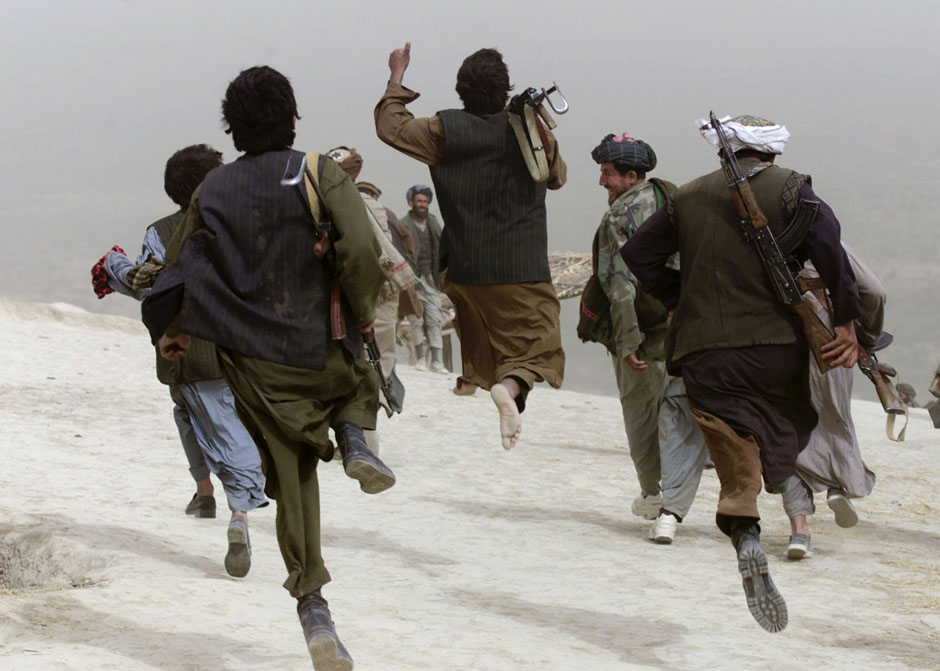
They look seriously pleased to be coming out of the line. One has his safety
catch on; a bit of a softy?
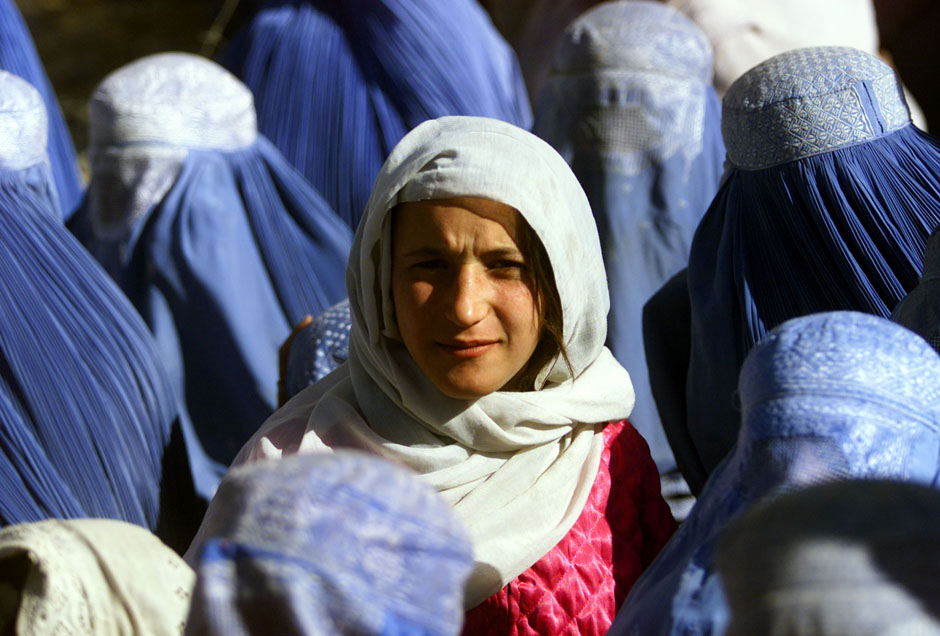
A hard woman. There is no love in her.
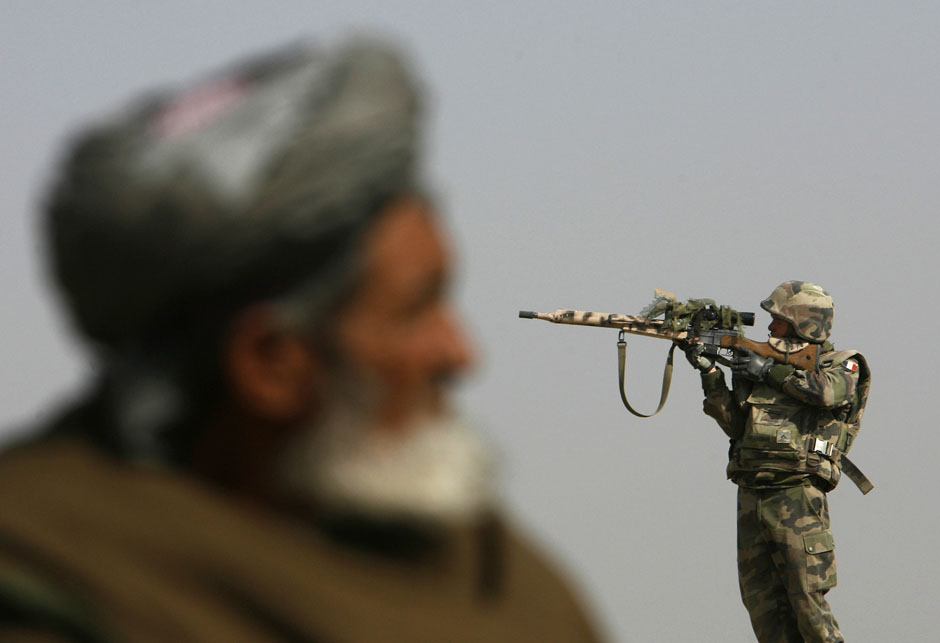
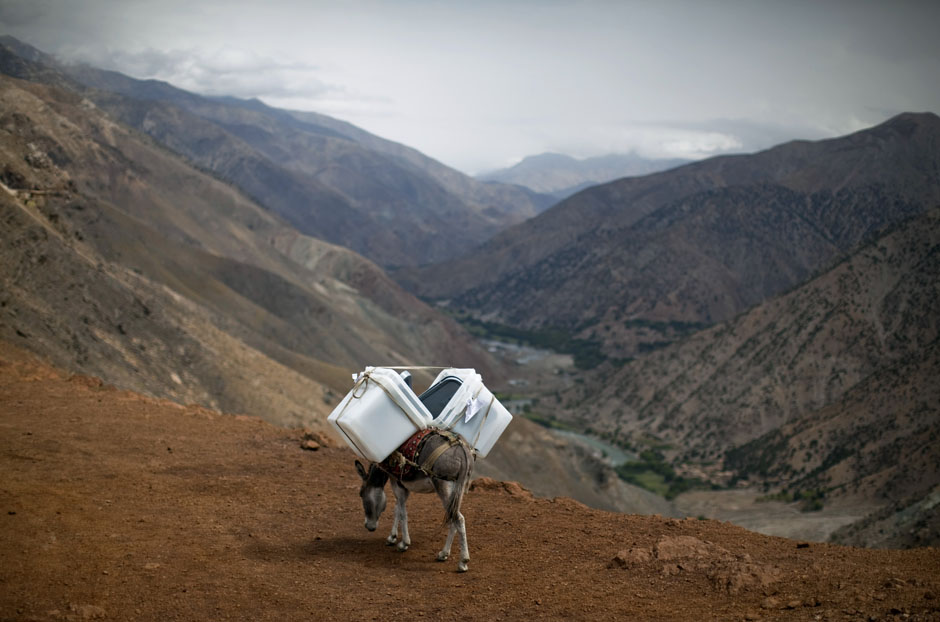
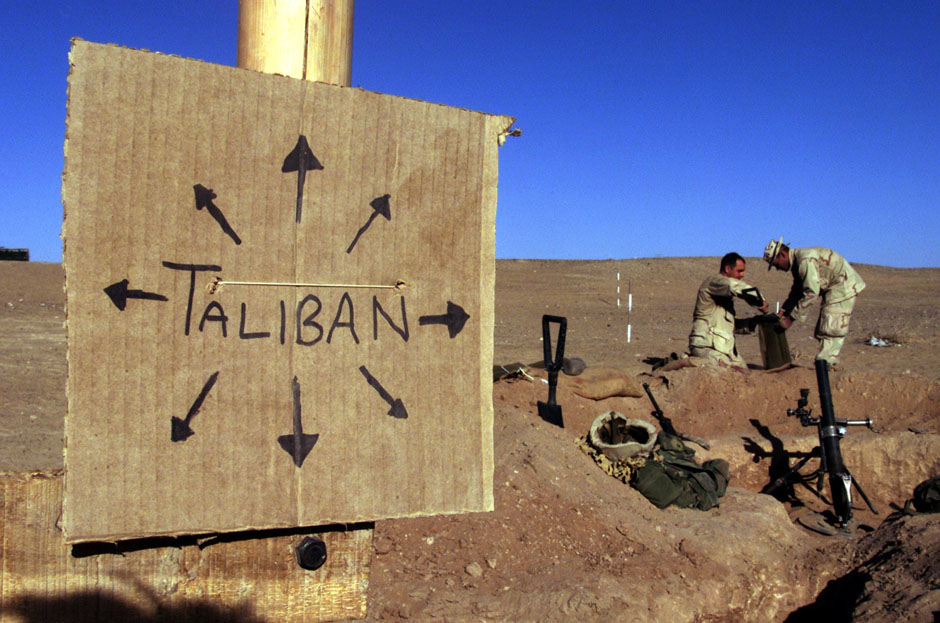
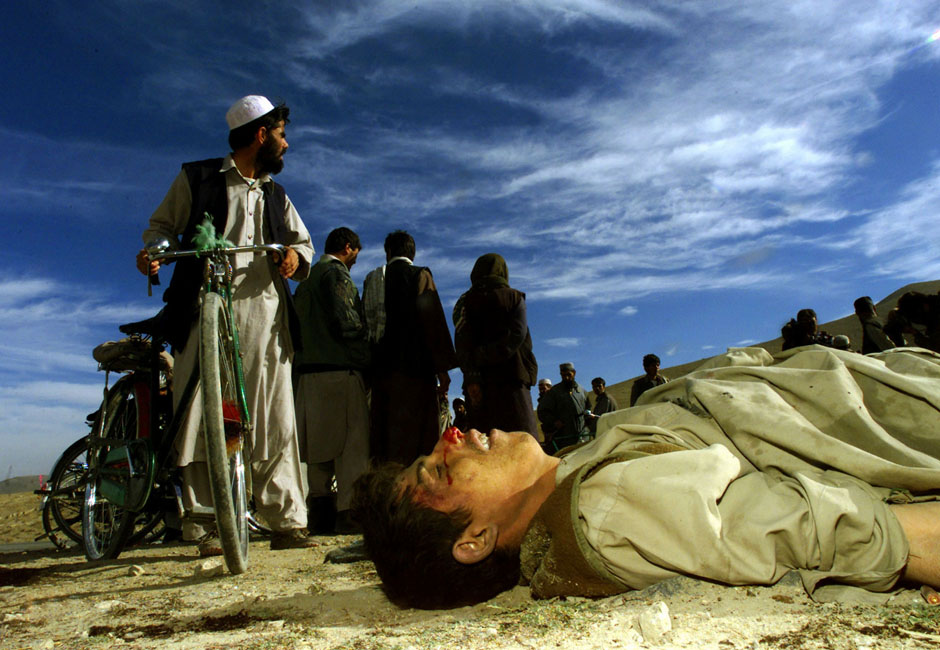
The blood is fresh.
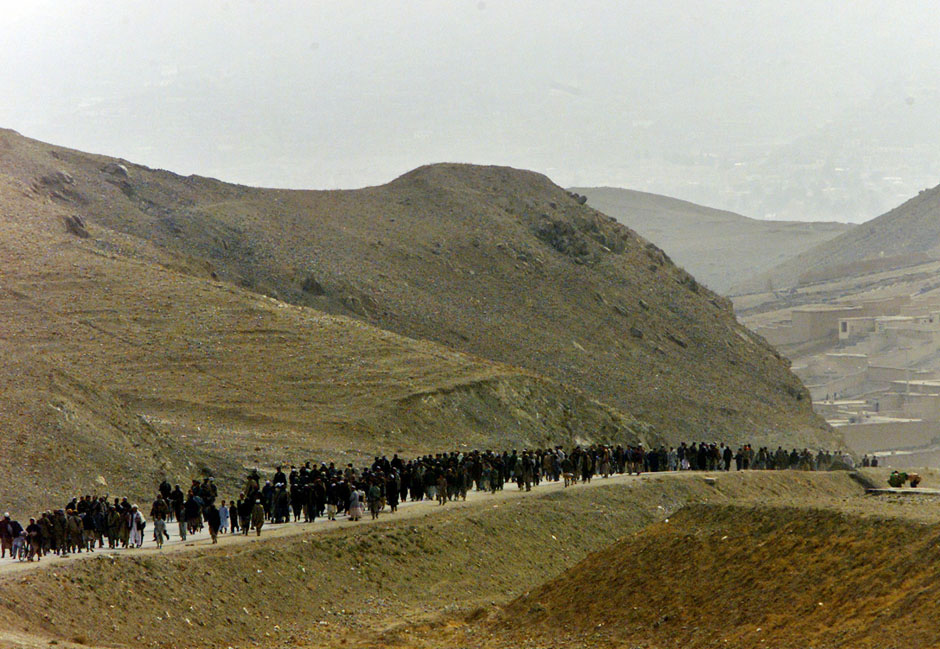
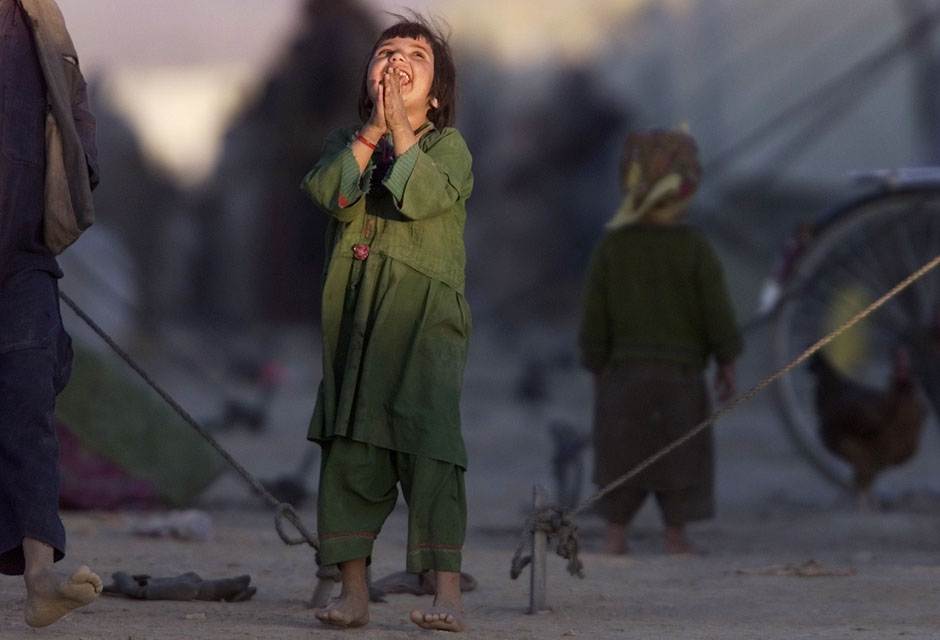
They are easy to please, sometimes.
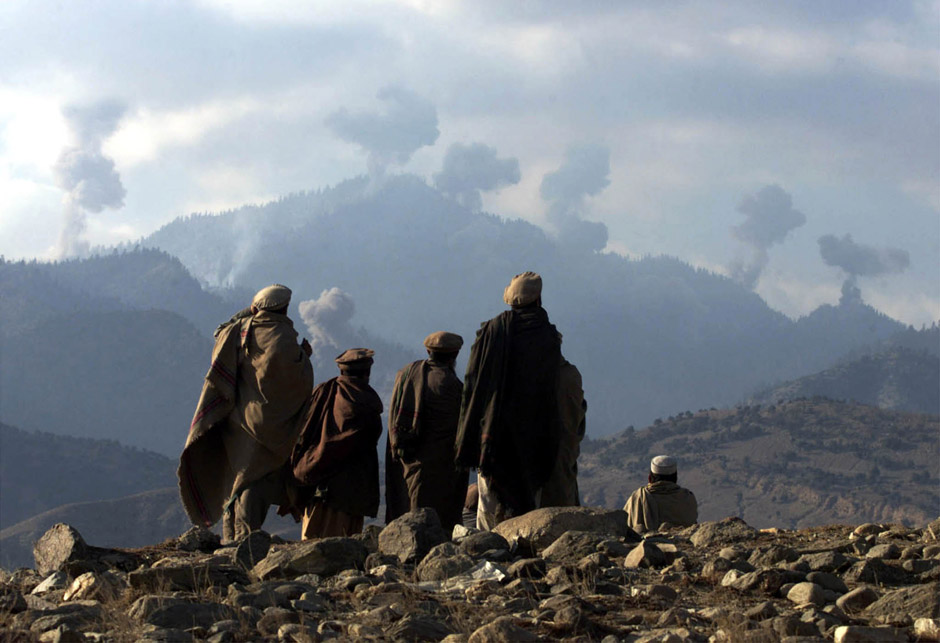
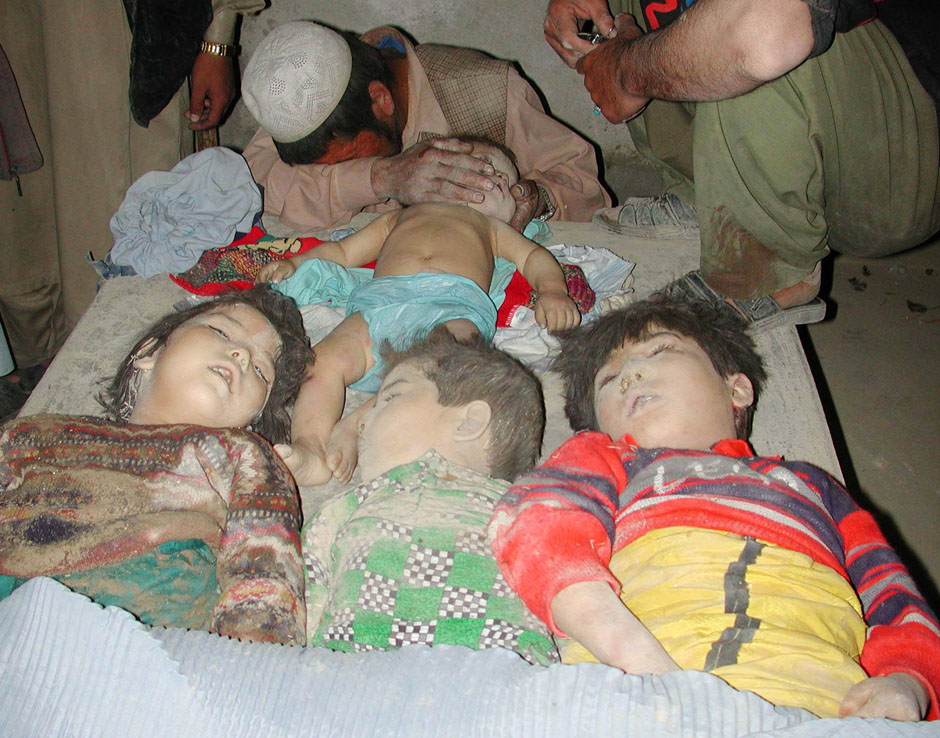
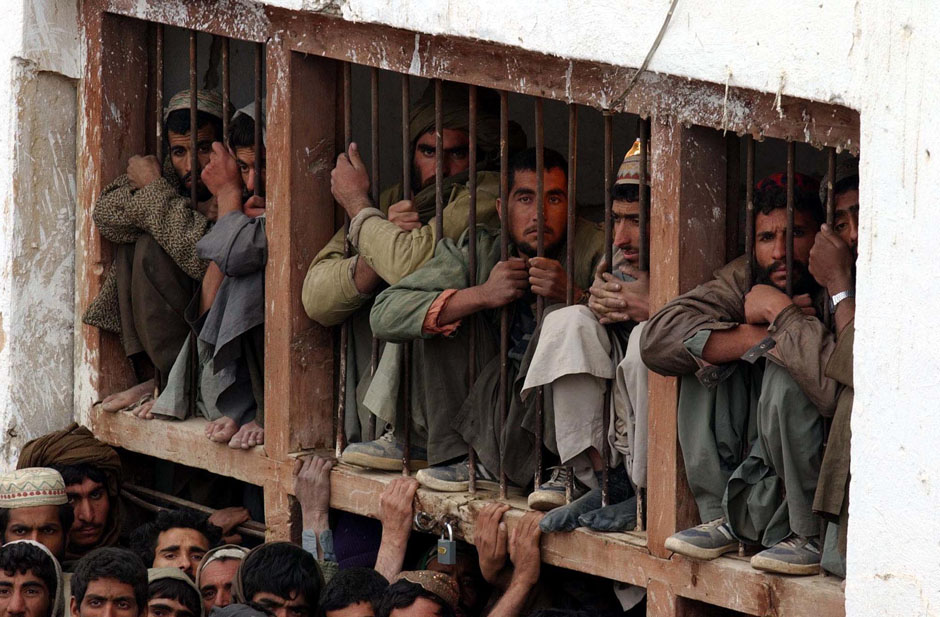
Luxury is not the word.
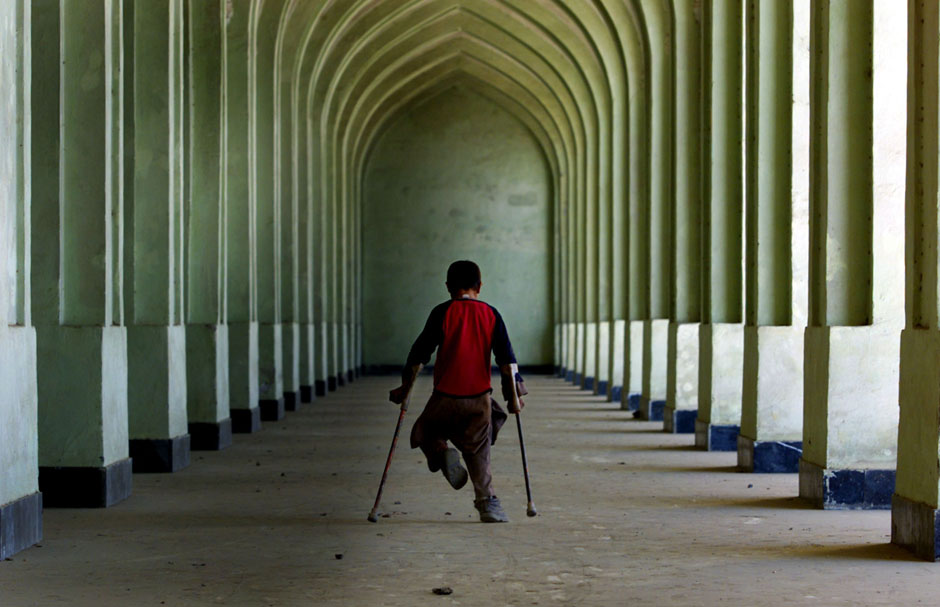
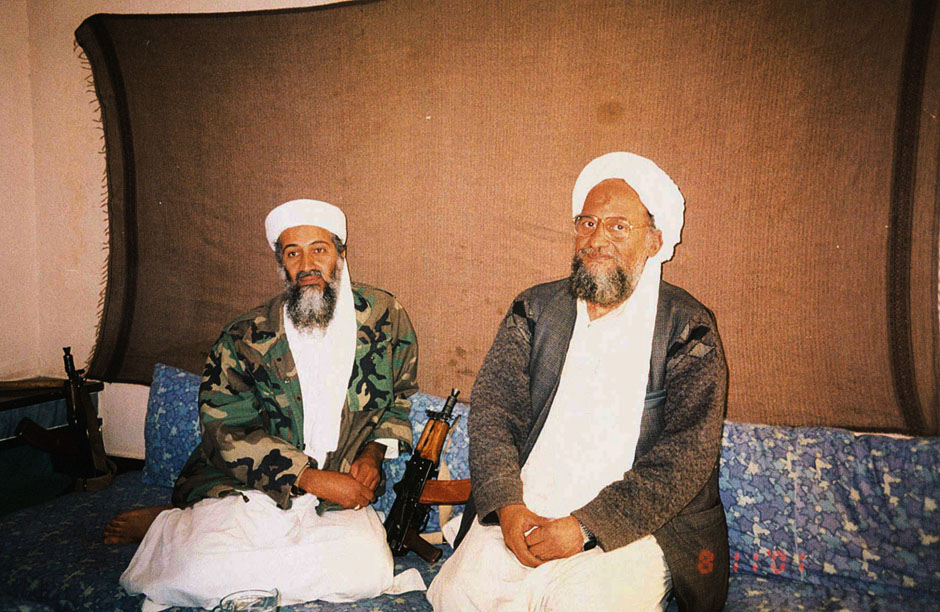
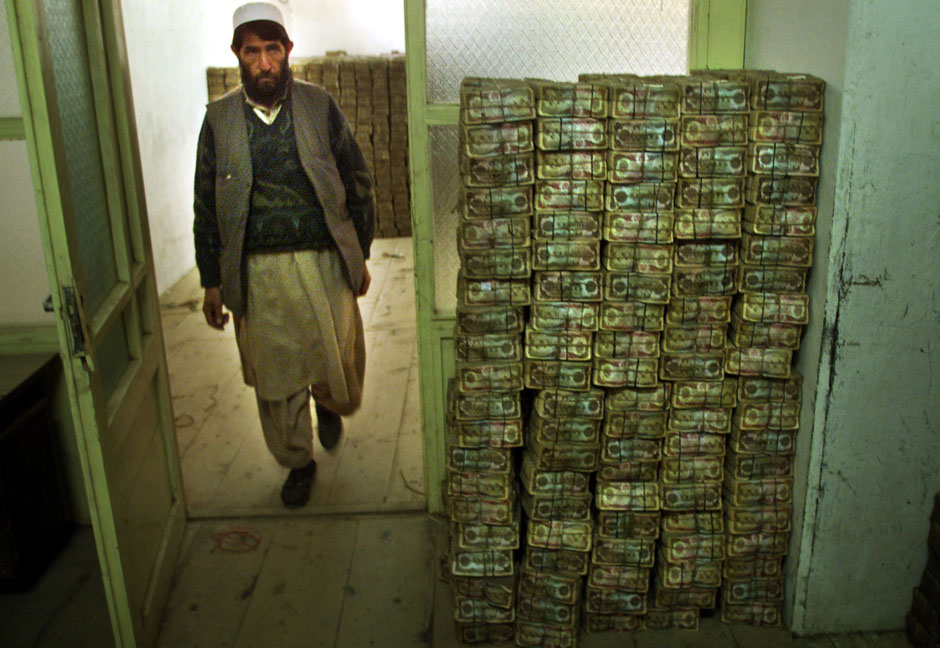
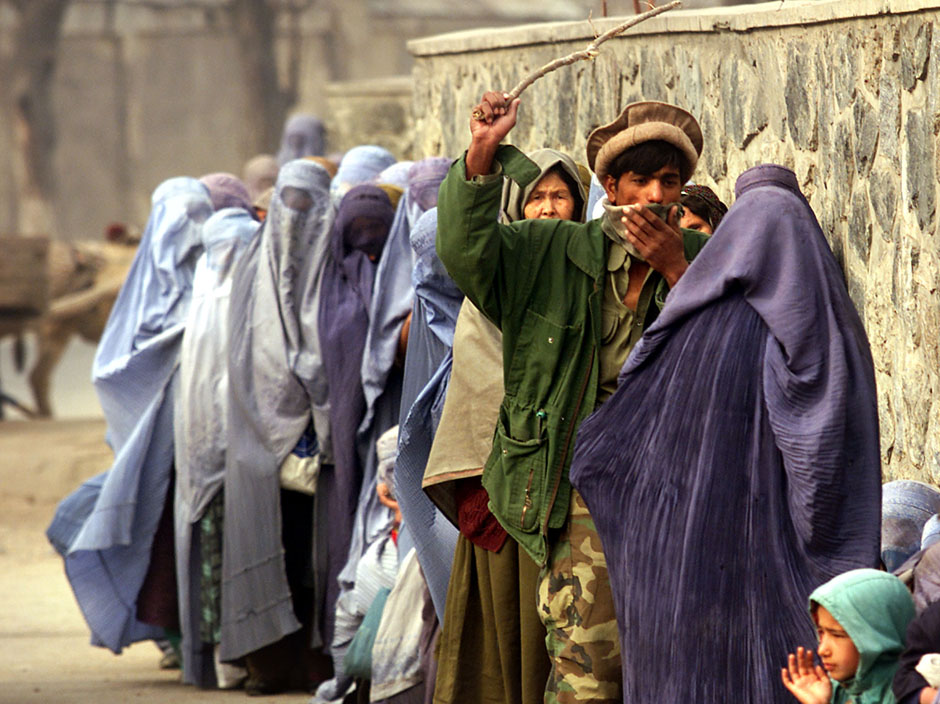
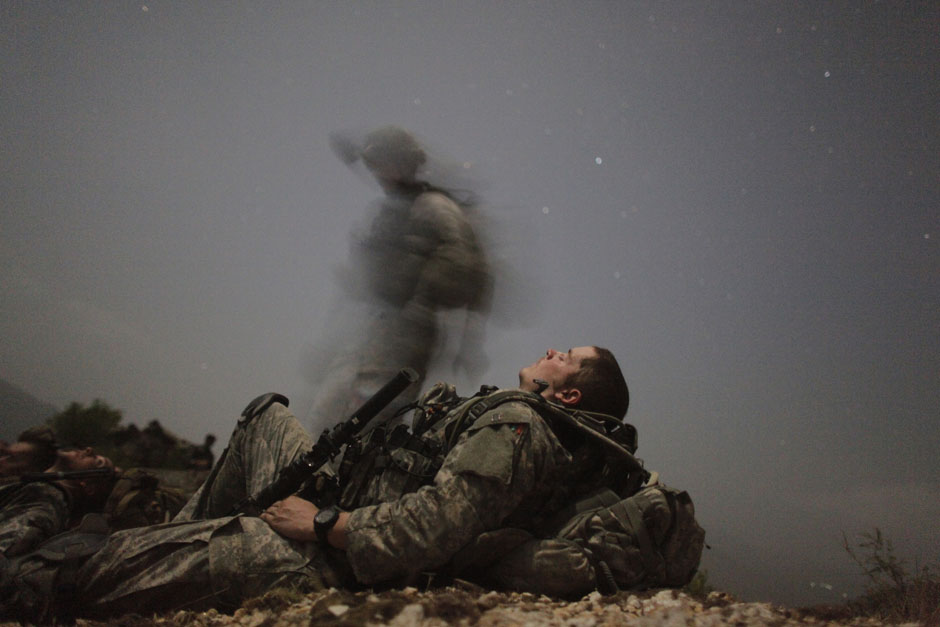
He is tired.
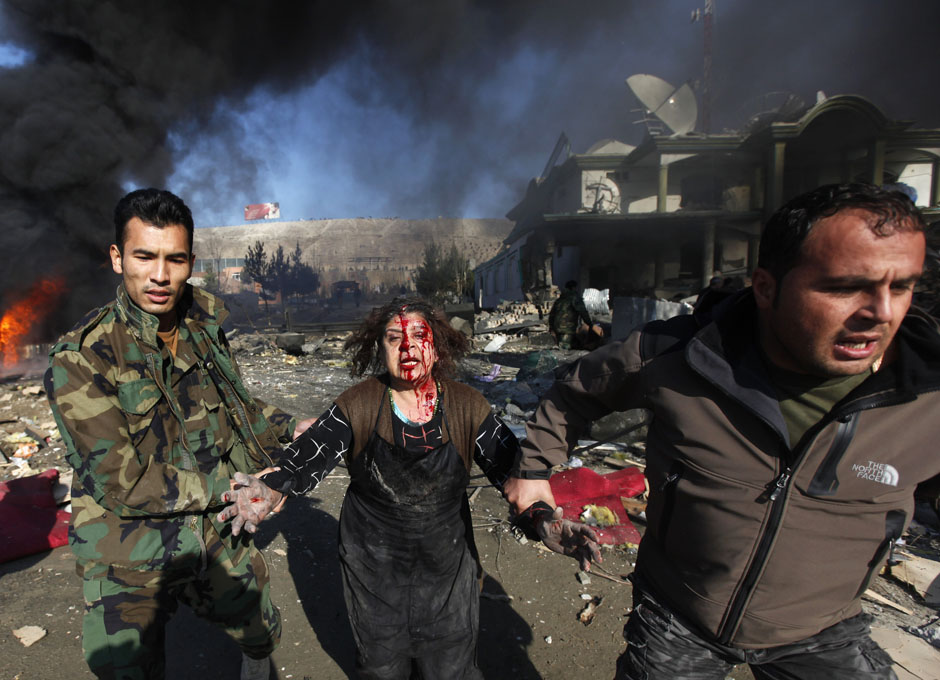
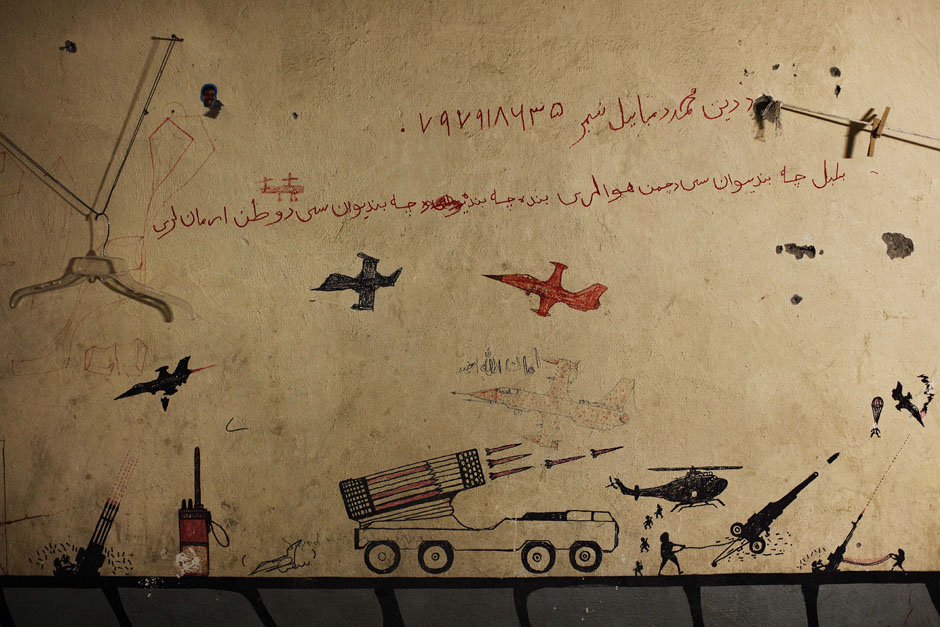
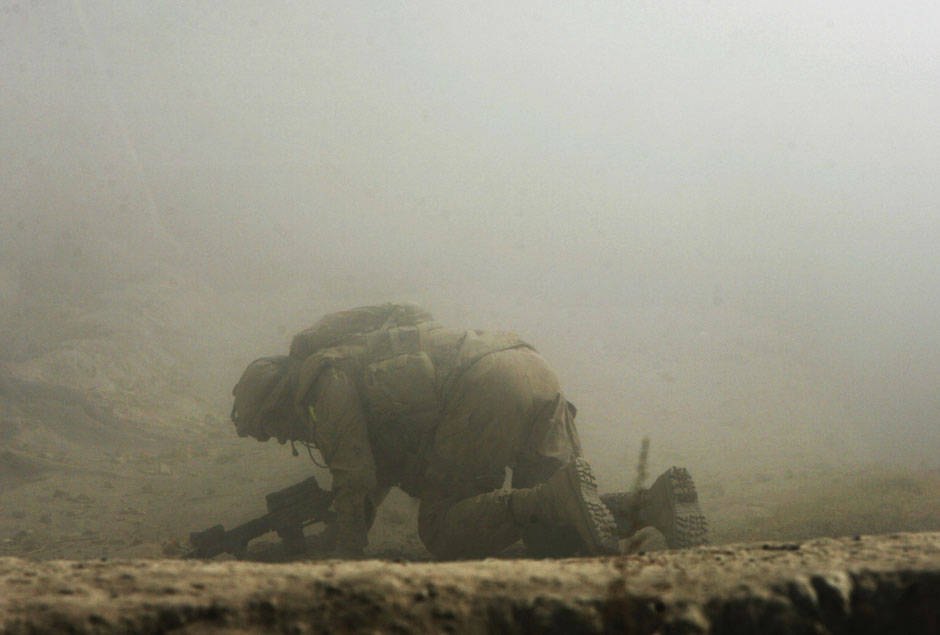
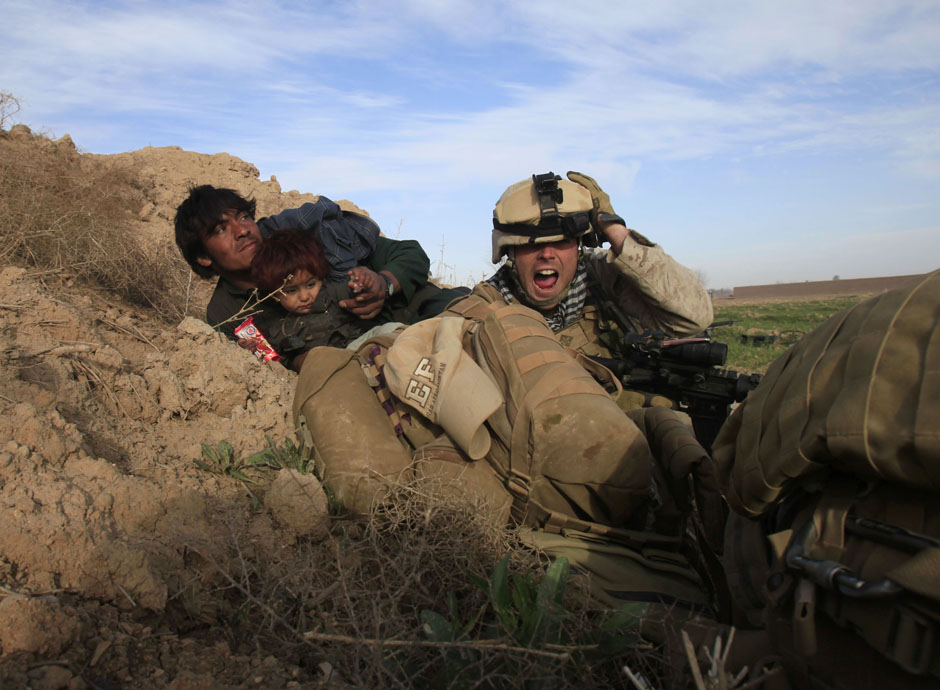
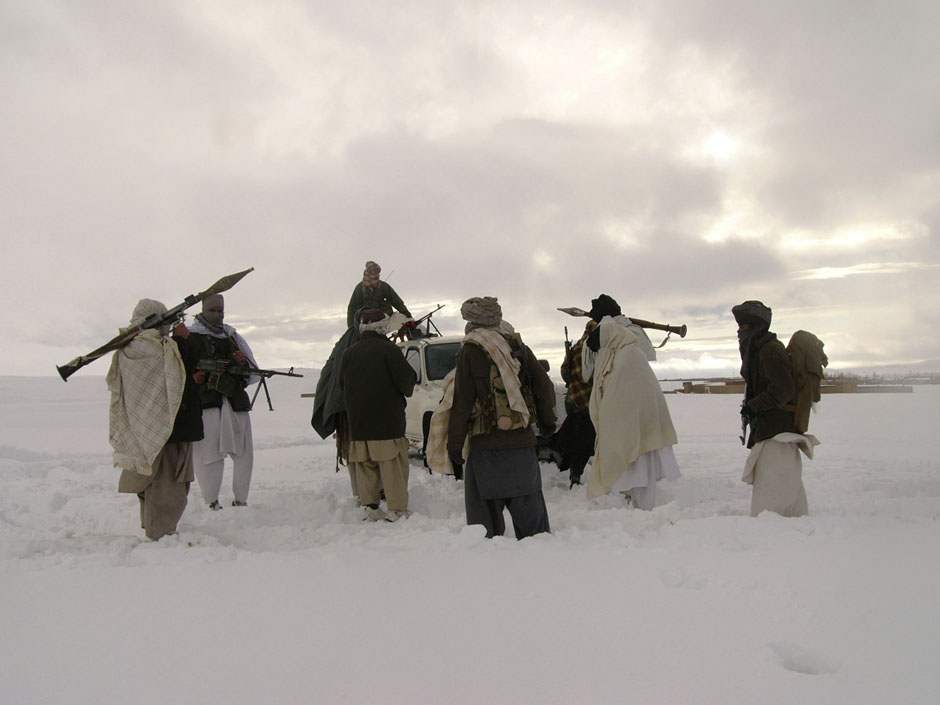
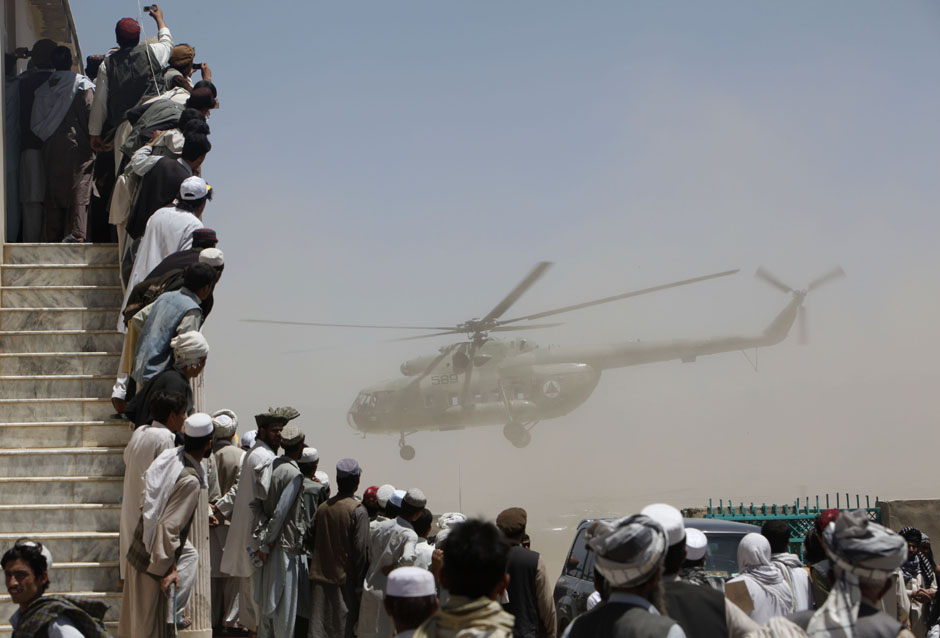
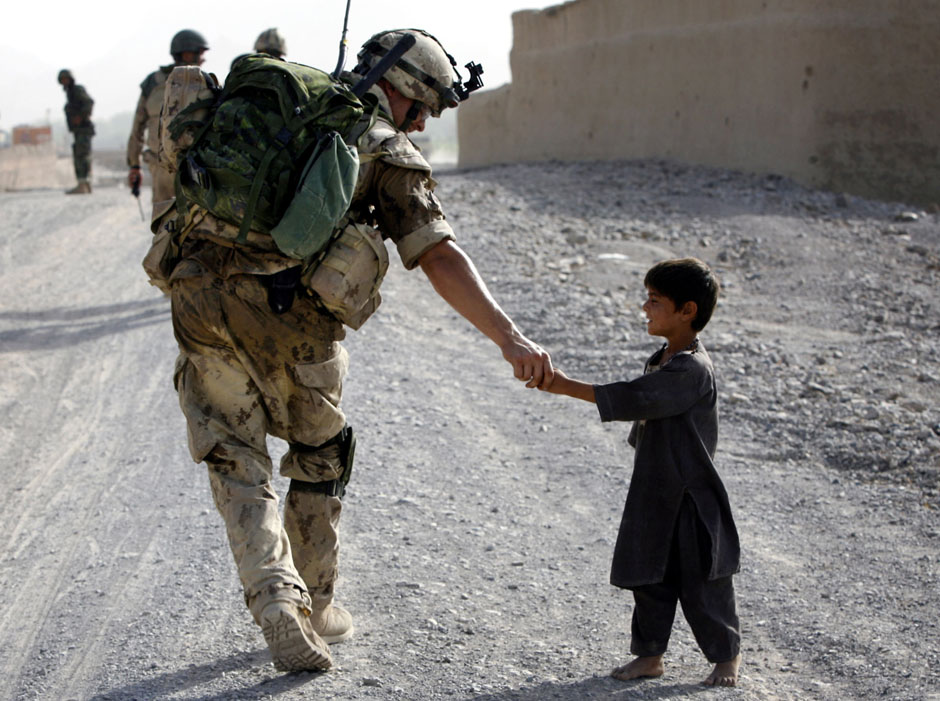
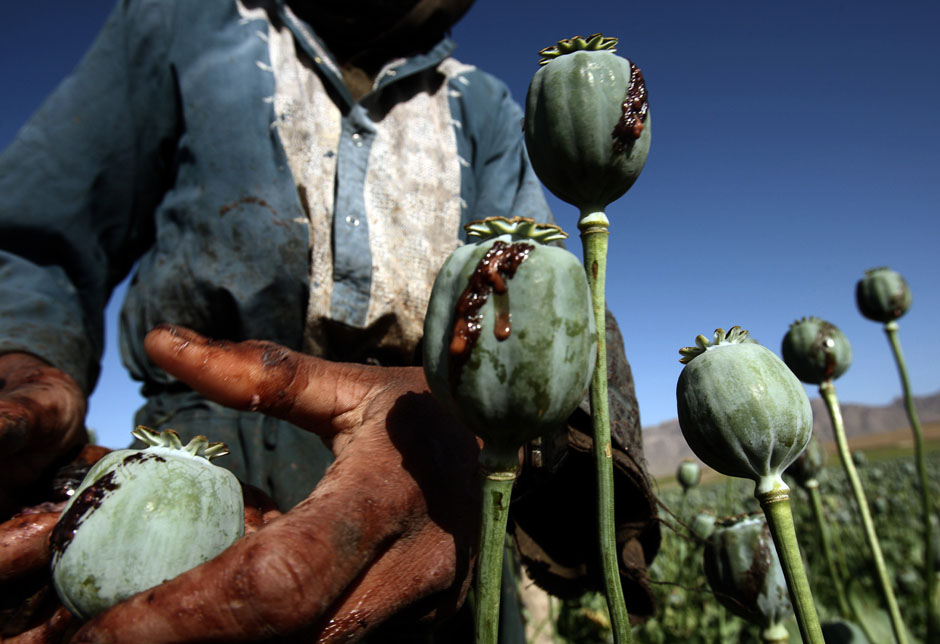
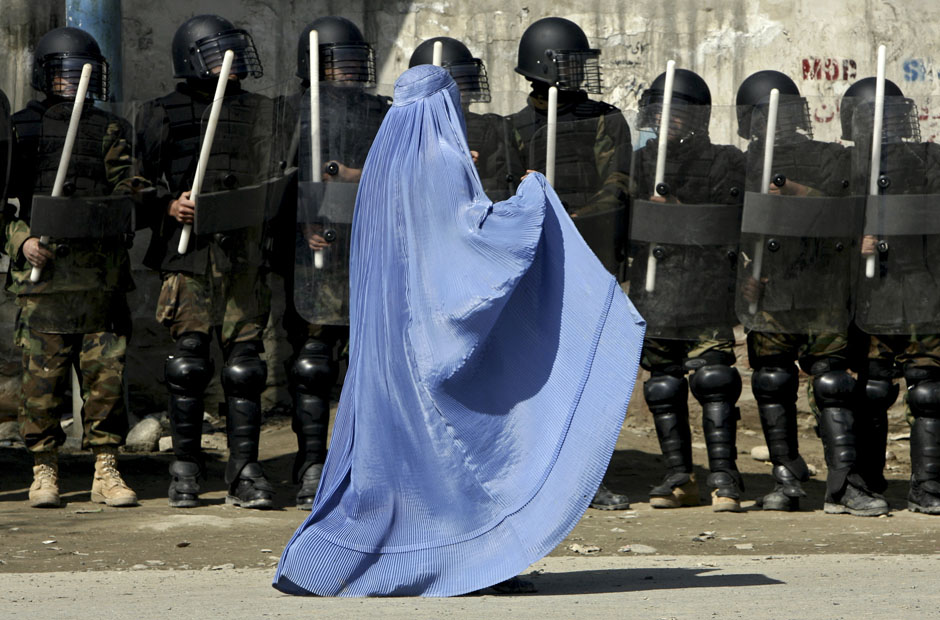
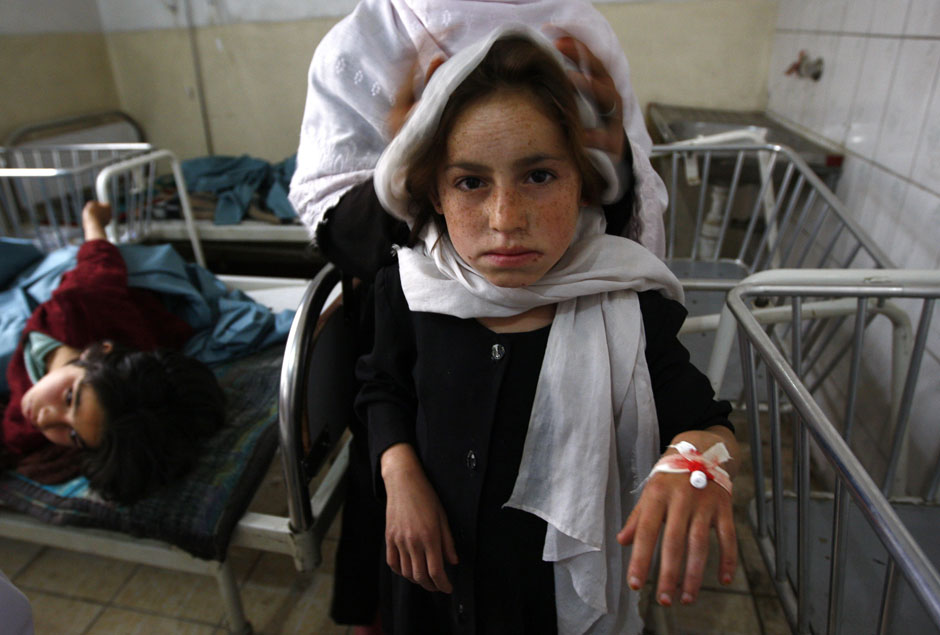
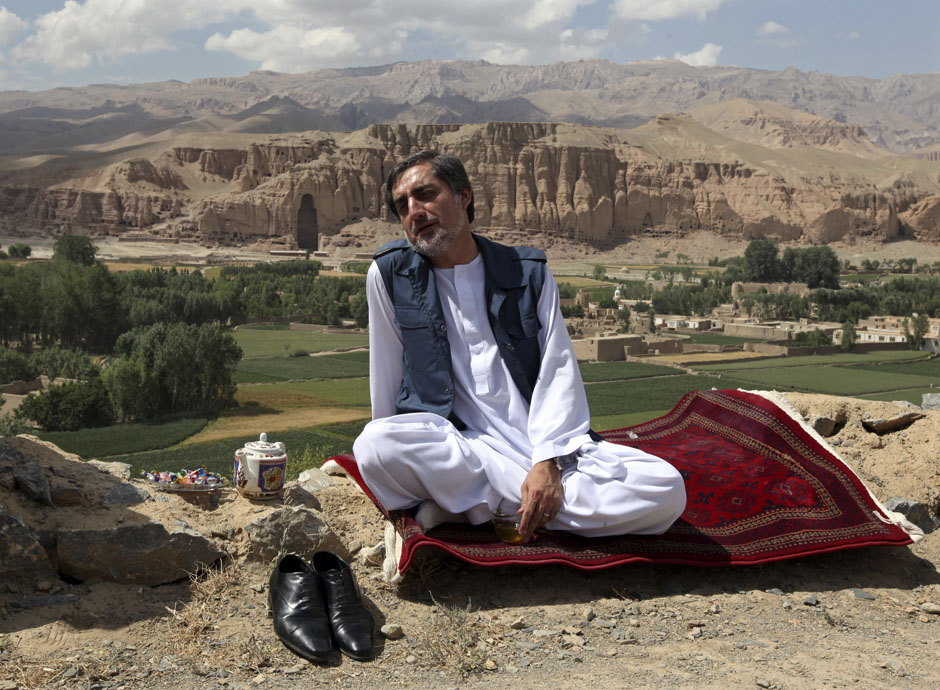
Behind is the slot where a large statue of the Lord Buddha stood.
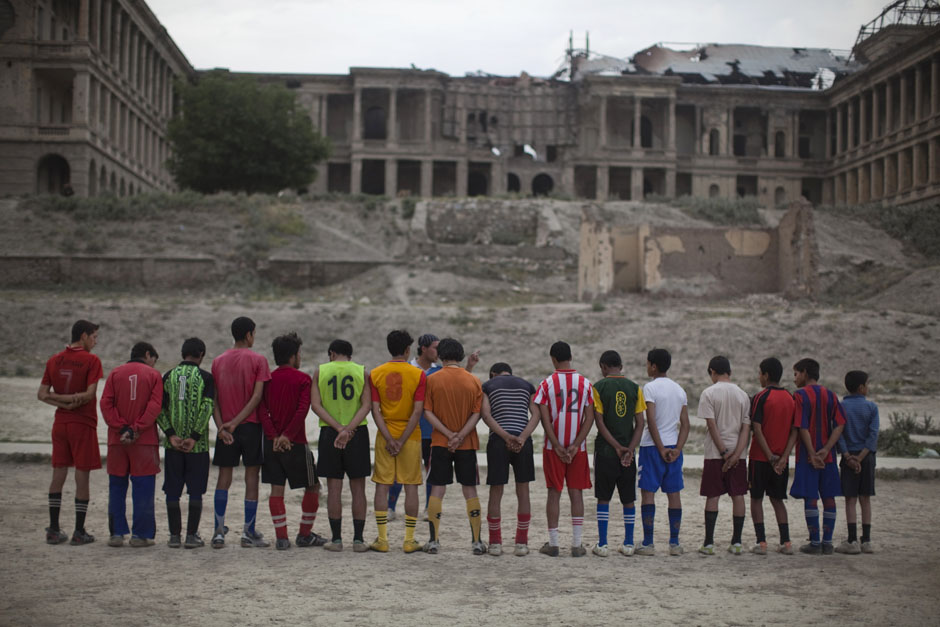
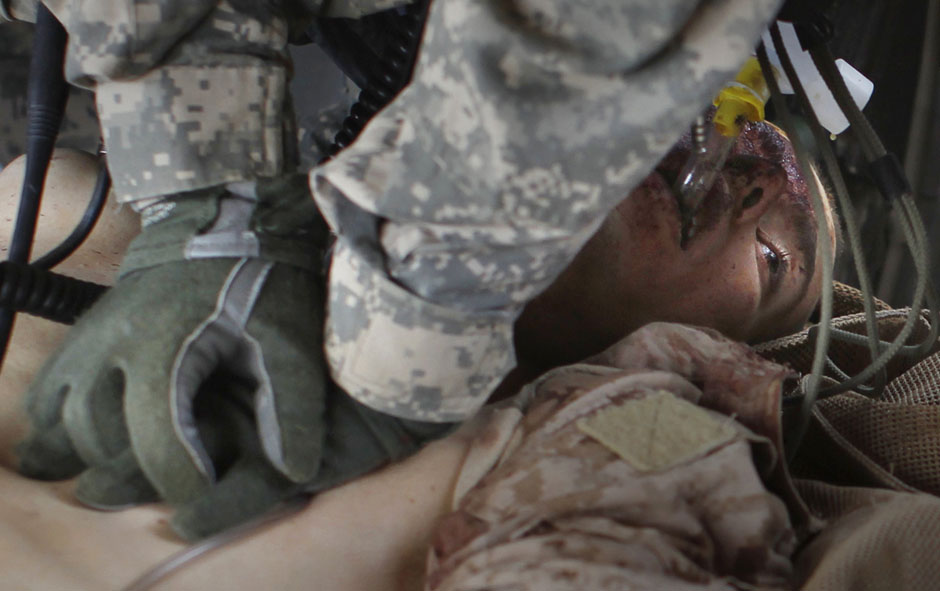
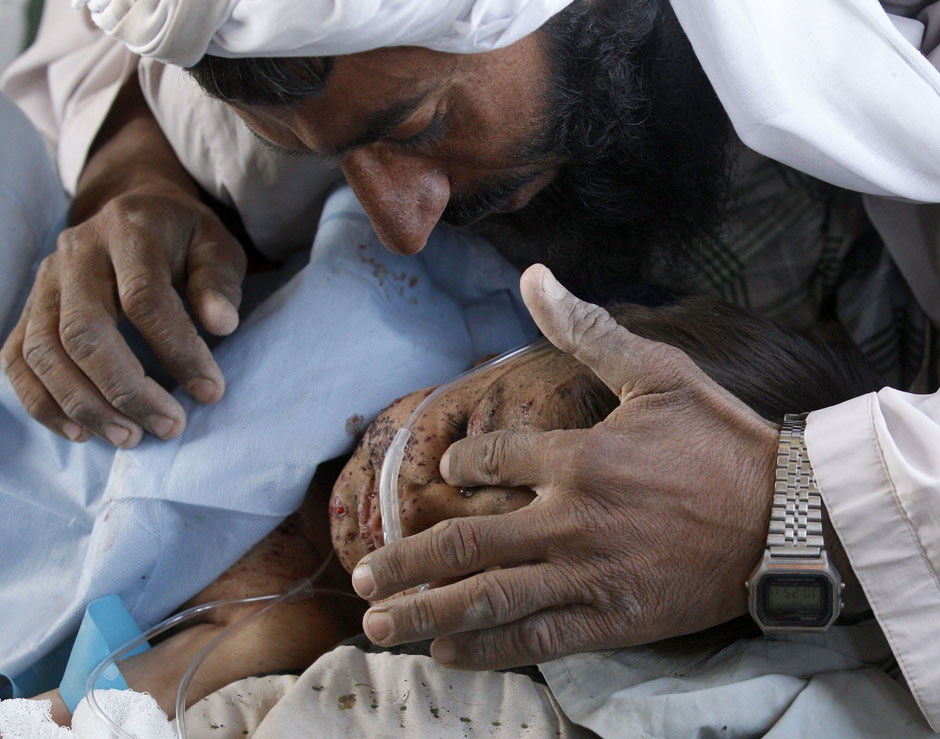
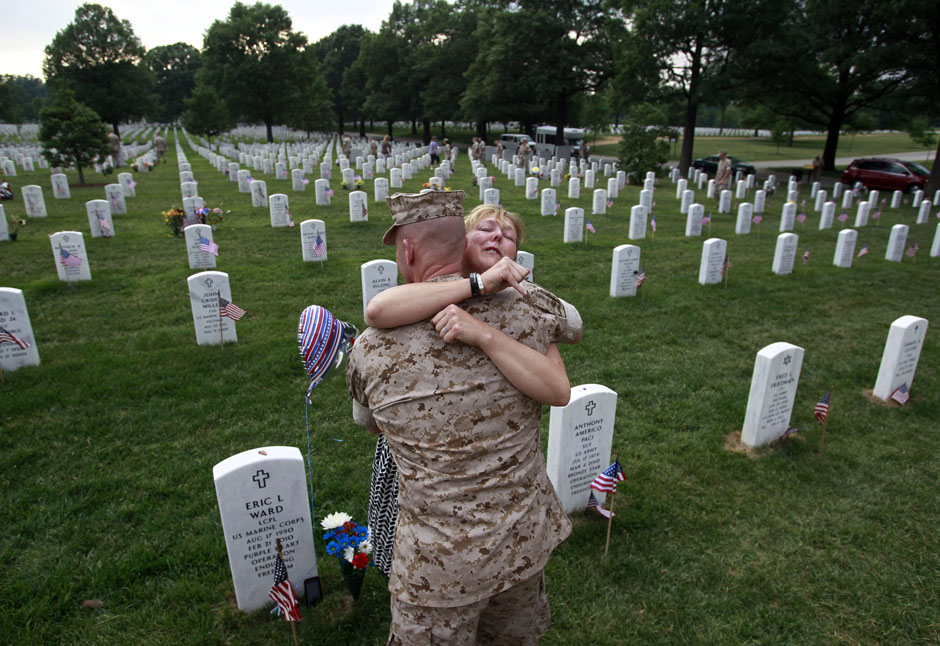
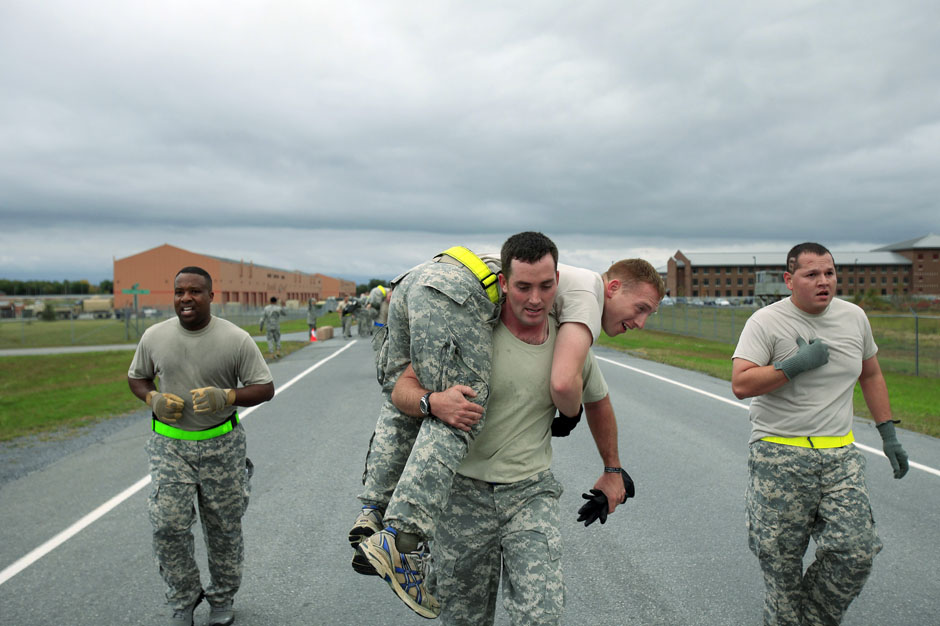
The officer looks all right. So does the lad he is carrying. The other two are
fat, too fat to be real soldiers.
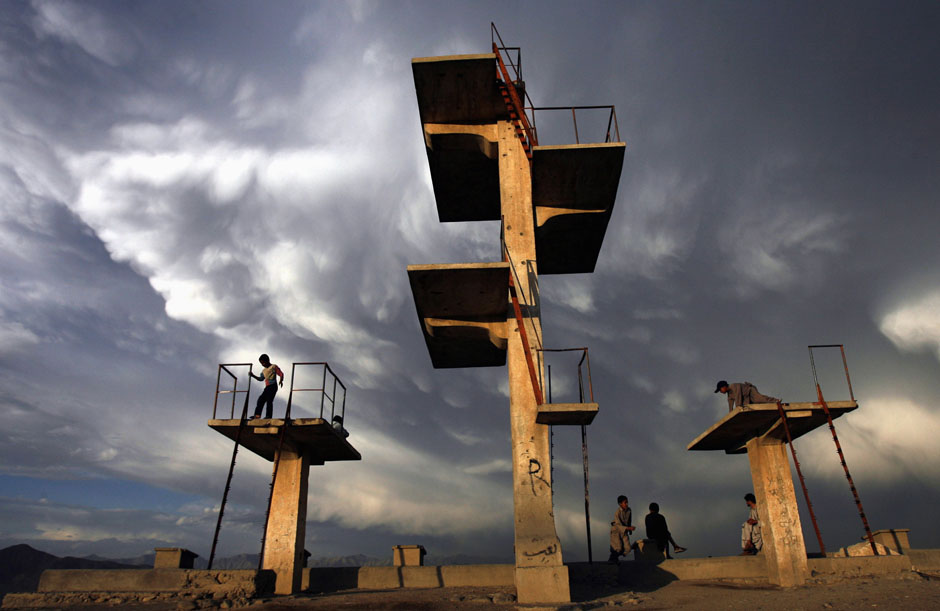
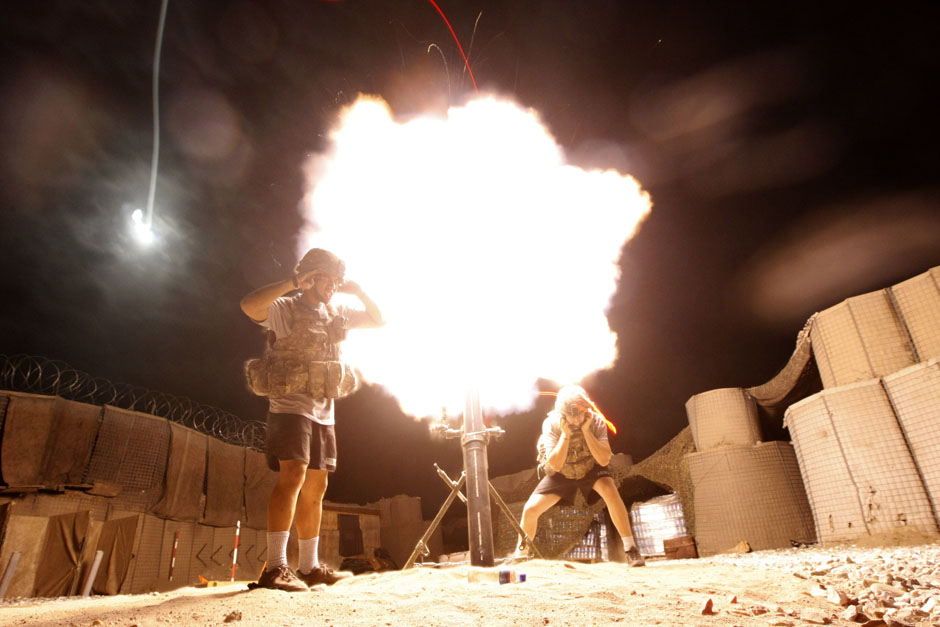
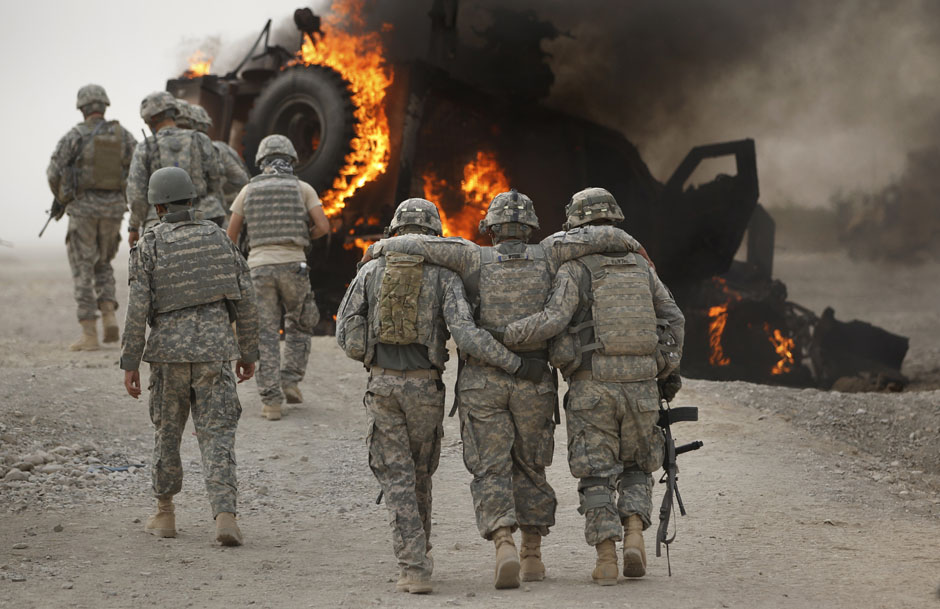
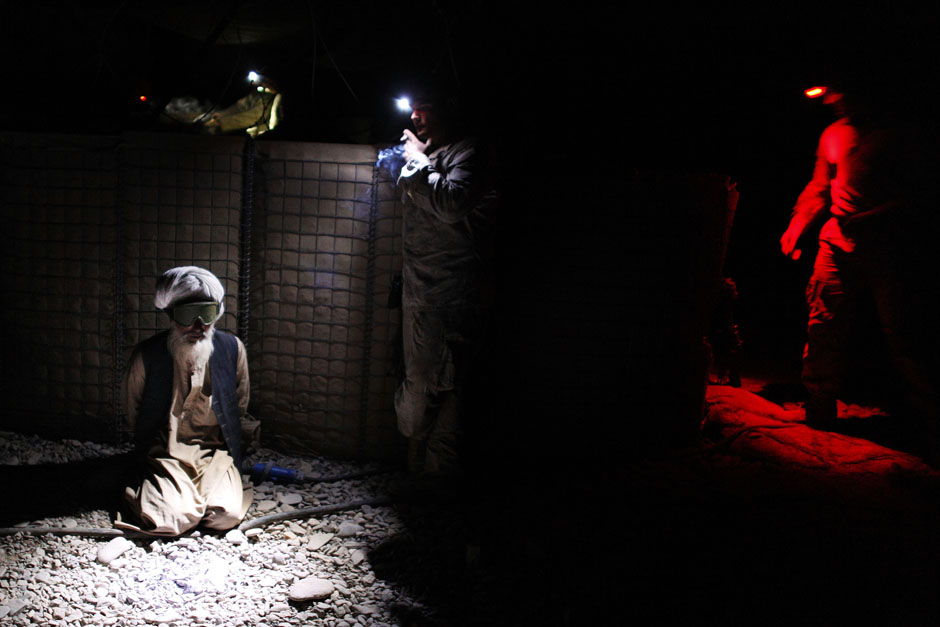
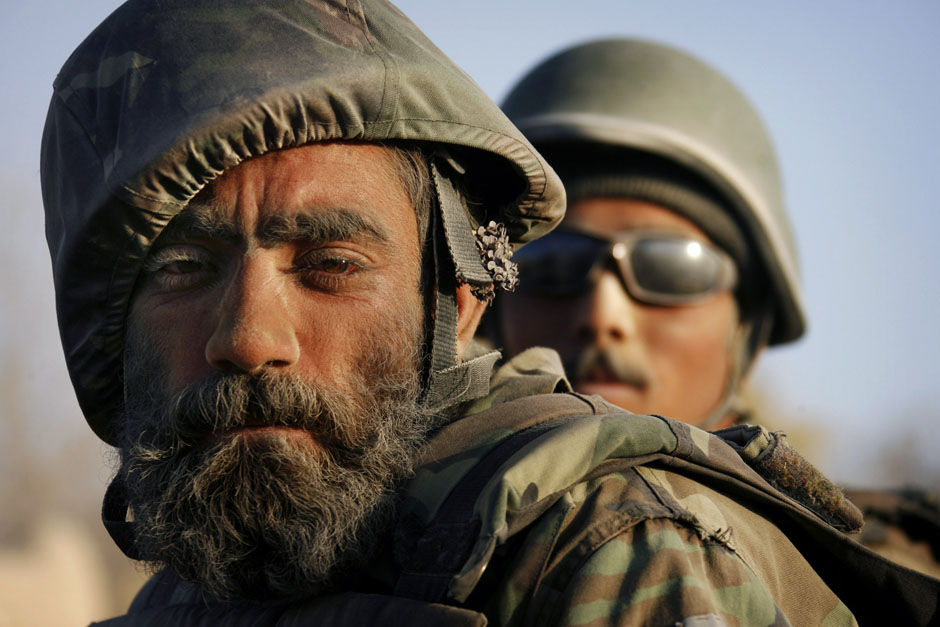
Friendly? I would not trust him.
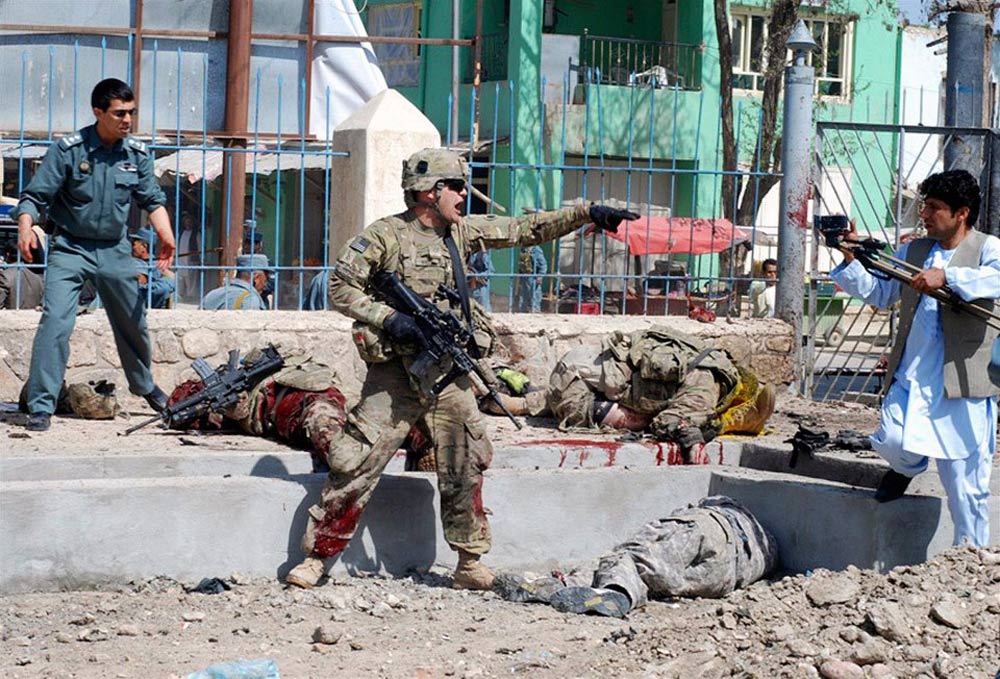
From Michael Yon. Source unknown [ make that
http://www.apimages.com/Search.aspx?st=k&remem=x&entity=&kw=gul+buddin+elham&intv=None&shgroup=-10&sh=10
]. Three(?) fresh dead, two American.
http://www.michaelyon-online.com/apache-apocalypse-real-faces-of-war.htm
It was a suicide bomber, yes. It was a new developing tactic in our AO. They
would outfit a couple of suicide vests on a couple of guys, put them on
motorcycles, then let them drive around until they found a target of
opportunity.
The Afghan with the camera was only one of many. It occurred close to an Afghan
news station, TV and Radio. The journalists poured out of the building with
their cameras, still photo and video, and documented everything. A couple of
journalists were on scene when it happened.
It was one of those missions to build partnerships and help improve the lives of
the local villagers. 12 civilians were also killed, including an 8 year old
child. Several Afghan policemen were also killed along with the Command Sergeant
Major (equivalent) from the Afghan army unit partnered with us.